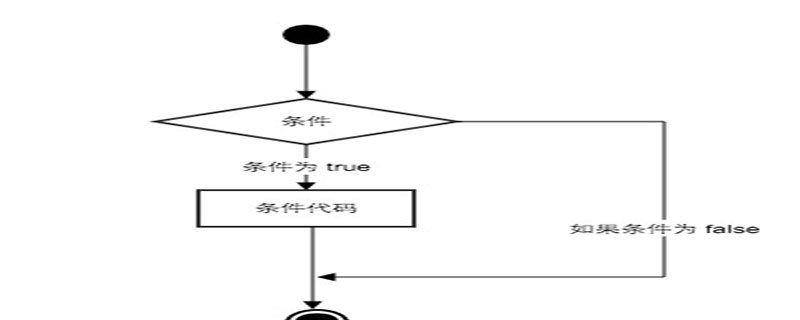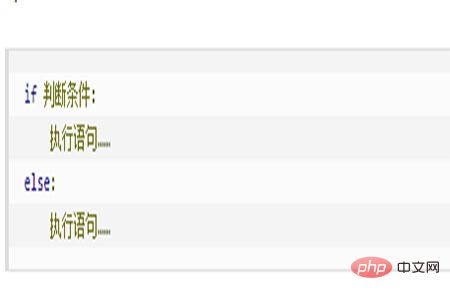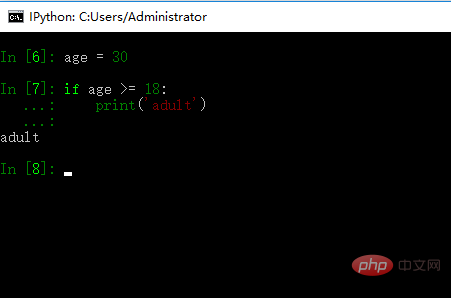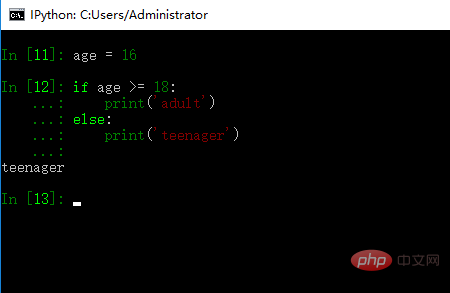How to write python judgment statement
We have learned Python's data types and related knowledge before. Now we can start writing Python programs, starting with the if conditional judgment.

#The Python programming language specifies that any non-zero and non-empty (null) value is true, and 0 or null is false.
The if statement in Python programming is used to control the execution of the program. The basic form is:

For example, we define a variable age, its value is 30, then use if to determine whether it is >= 18. At this time, the expression of the if statement is true and the else statement is omitted. As follows

In the Python language, the conditional structure consists of if-else statements, and the else statements can also be omitted. The if statement consists of three parts: the keyword itself, the conditional expression used to determine whether the result is true or false, and the code block that is executed when the expression is true or non-zero. The else statement is used in conjunction with the if statement. If the value of the conditional expression of the if statement is true, the statement block after the if statement is executed; if the value of the conditional expression of the if statement is false, the statement block after the else is executed.
For example

It can be seen from the above output that when the age variable does not meet the if condition, the else statement is executed and the output result is teenager
The above is the detailed content of How to write python judgment statement. For more information, please follow other related articles on the PHP Chinese website!

Hot AI Tools

Undresser.AI Undress
AI-powered app for creating realistic nude photos

AI Clothes Remover
Online AI tool for removing clothes from photos.

Undress AI Tool
Undress images for free

Clothoff.io
AI clothes remover

AI Hentai Generator
Generate AI Hentai for free.

Hot Article

Hot Tools

Notepad++7.3.1
Easy-to-use and free code editor

SublimeText3 Chinese version
Chinese version, very easy to use

Zend Studio 13.0.1
Powerful PHP integrated development environment

Dreamweaver CS6
Visual web development tools

SublimeText3 Mac version
God-level code editing software (SublimeText3)

Hot Topics
 What are the common if statements in computer programming?
Jan 29, 2023 pm 04:31 PM
What are the common if statements in computer programming?
Jan 29, 2023 pm 04:31 PM
A common if statement in computer programming is a conditional judgment statement. The if statement is a selective branch structure. It selects the execution path based on clear conditions, rather than strictly following the order. In actual programming, the appropriate branch statement must be selected according to the program flow. It changes the execution according to the result of the condition. program; the simple syntax of the if statement is "if (conditional expression) {//code to be executed;}".
 Conditional control structures in PHP
Mar 10, 2024 pm 09:36 PM
Conditional control structures in PHP
Mar 10, 2024 pm 09:36 PM
Conditional control structure in PHP In PHP programming, conditional control structure is a very important syntax, which allows the program to execute different code blocks based on different conditions. By using conditional control structures, we can implement the branching logic of the program and determine the execution path of the program based on the result of the condition. This article will introduce the commonly used conditional control structures in PHP, including if statements, else statements, elseif statements and switch statements, and give specific code examples. The if statement is the most basic conditional control in PHP
 How to solve if statement duplication error in Python code?
Jun 24, 2023 pm 04:10 PM
How to solve if statement duplication error in Python code?
Jun 24, 2023 pm 04:10 PM
Python is a very powerful and popular programming language that is widely used in fields such as data analysis, machine learning, and web development. However, when writing Python code, we will inevitably encounter repeated if statements, which may lead to problems such as inefficient code and complicated maintenance. Therefore, this article will introduce some methods and techniques to solve repeated if statement errors in Python code. Simplify if statements using Boolean operators In many cases, repeated logic in an if statement can be simplified into Boolean operations. example
 Advanced techniques for if statements in Go language: Optimizing code quality
Apr 07, 2024 pm 03:45 PM
Advanced techniques for if statements in Go language: Optimizing code quality
Apr 07, 2024 pm 03:45 PM
Master the advanced skills of if statements in Go language and optimize code quality: use if-else chains to check multiple conditions and execute the corresponding code block according to each condition. Compares values using relational expressions and returns a Boolean value. Control code flow by combining Boolean values with the help of logical operators. Use switch statements to execute different blocks of code based on variable values.
 In-depth analysis of Python flow control statements: the use of if, else, elif, while, and for
Jan 20, 2024 am 10:21 AM
In-depth analysis of Python flow control statements: the use of if, else, elif, while, and for
Jan 20, 2024 am 10:21 AM
Detailed explanation of Python flow control statements: if, else, elif, while, for In programming, flow control statements are essential. They are used to determine the execution flow of the program based on conditions. Python provides several commonly used flow control statements, including if, else, elif, while and for. This article explains these statements in detail and provides specific code examples. if statement The if statement is used to determine whether a certain condition is true. If the condition is true, execute the if code block.
 Control flow statements: if and switch statements
Jun 19, 2023 pm 04:52 PM
Control flow statements: if and switch statements
Jun 19, 2023 pm 04:52 PM
Control flow statement: if and switch statement In programming, control flow statement is a key concept, which is used to control the way and order of program execution. Control flow statements can change the execution order of the program based on conditions, allowing the program to perform different operations according to specific situations. Among them, if statement and switch statement are one of the most commonly used control flow statements. if statement The if statement is used in a program to determine whether to execute some code based on a condition. The syntax is as follows: if(condition){/
 Detailed explanation of techniques and precautions for Python flow control statements
Jan 20, 2024 am 09:38 AM
Detailed explanation of techniques and precautions for Python flow control statements
Jan 20, 2024 am 09:38 AM
Tips and precautions for using Python flow control statements. Python is a high-level programming language, and flow control statements are an important tool for implementing program logic. Mastering the use of flow control statements can improve the readability and efficiency of the code. This article will introduce the usage skills of Python's commonly used flow control statements if, for and while, and provide corresponding code examples. 1. If statement The if statement is one of the most commonly used flow control statements in Python. It is used to execute different codes based on conditional judgments.
 Common mistakes in Go language if statements and how to avoid them
Apr 07, 2024 am 11:03 AM
Common mistakes in Go language if statements and how to avoid them
Apr 07, 2024 am 11:03 AM
Common mistakes when using if statements include incorrect use of comparison operators, omitting braces, using multiple conditions, and using elseif as the default case. To avoid these errors, use == for comparisons, always use braces, use separate if statements or Boolean operators to check multiple conditions, and always use else as the default case.






